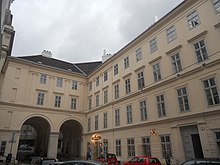Franz Xaver Ehmann
Franz Xaver Ehmann (* 1801 in Zirc ; † January 30, 1872 in Vienna ) was an Austrian master builder and architect .
Life
Franz Ehmann was born as the son of Johann Michael Ehmann (1761–1829) and his wife Elisabeth (née Gschwind) in Hungary , where the father was a princely Esterházy court architect . After an apprenticeship as a master builder, he studied at the Academy of Fine Arts Vienna in 1821 and probably lived with his uncle Karl Ehmann , with whom he was registered as a draftsman in 1824. He practiced with Carl Högl and on October 11, 1830 received the certificate of the test taken on February 21, 1830, according to which he "can be recommended to everyone". A year later he was accepted into the builders' guild .
Ehmann worked with his uncle and when he died in 1829 at the age of 52, he continued to run the prosperous company and married his long-time partner Amalia Ottilie Bisenus (* approx. 1800–1840). After her death in 1843 he married Marie Henriette, nee Langer, (* 1825).
Franz Ehmann died of spinal cord paralysis at the age of 71.
meaning
Franz Ehmann was one of the builders who have been forgotten today, but who in their time made an important contribution to the cityscape of Vienna in Vormärz . Almost all of his buildings were located in the central districts of Vienna, which were particularly affected by the hostilities of World War II , so that only a few of them have survived. Others were in some cases significantly changed, such as a residential building from 1838 in the 2nd district of Vienna , which was adapted in 1863 and finally expanded by Adolf Krischanitz in 2007 to the "Novotel Wien City Hotel" with a glass facade and five storeys.
Like his uncle, Ehmann designed simple rental houses with grooved base zones and straight window roofs . In corner houses the corners were also grooved and in some buildings the windows were only cut into the facade. In some cases, he connected the ground floor with the mezzanine floor with grooves to form a high plinth, as in the house at Berggasse 13 from 1835.
He received the most important order from Count Abensperg and Traun in 1837 with the construction of the “Traunsches Haus” rental complex, which was directly connected to the apartment complex that his uncle Karl had built in 1817. This new building with its 37 axes was unimaginable for the circumstances at the time. With another extension that Ehmann built a few years later, the multi-courtyard complex became one of the largest pre-March rental houses in Vienna. The mighty facades are structured by risalits and giant pilasters and thus show the beginning of a development that generally took hold from the middle of the century.
Towards the end of his creative period, Ehmann showed himself to be at the height of his time with the furnishing of the “Dreher” residential building, by providing it with richer decor in the forms of the Viennese neo-Renaissance .
Works
- 1835: House, Vienna 8, Wickenburggasse 26 (not preserved)
- 1835: Rental house, Vienna 9, Berggasse 13
- 1836: Rental house, Vienna 4, Belvederegasse 35 (barrel not original)
- 1837: “ Traunsches Haus ” rental house complex , Vienna 3, Traungasse 1 / Moroccanergasse 5 / Salesianergasse 6
- 1838: Archduke Carl's summer residence, Vienna 2, Ferdinandstraße 4 (not preserved)
- 1838: House, Vienna 4, Karolinengasse 24 (destroyed by bombs)
- 1838: Residential building, Vienna 2, Aspernbrückengasse 1 / Praterstraße 20 (in 2007 by Adolf Krischanitz expanded into the Hotel Novotel Urania with a 5-story structure)
- 1839: Apartment building of the widow and orphan society of medicine. Faculty, Vienna 3, Salesianergasse 8 / Zaunergasse 11
- 1841: Rental house, Vienna 2, Ferdinandstrasse 18
- 1841: former Palais Trauttmansdorff , Vienna 1, Herrengasse 21 (adaptation of the inner courtyard)
- 1844: Rental house, Vienna 1, Kärntner Straße 29–31 (destroyed in World War II)
- 1844: Rental house, Vienna 2, Afrikanergasse 11
- 1845: Rental house, Vienna 2, Praterstraße 28 (adapted by Jakop Flucher in 1853)
- 1863: Former Dreher residence, Vienna 1, Opernring 4 / Operngasse 8 (destroyed by bombs in 1945)
Web links
Individual evidence
- ^ Franz Xaver Ehmann. In: Architects Lexicon Vienna 1770–1945. Published by the Architekturzentrum Wien . Vienna 2007. accessed on September 9, 2014
| personal data | |
|---|---|
| SURNAME | Ehmann, Franz Xaver |
| ALTERNATIVE NAMES | Ehmann, Franz |
| BRIEF DESCRIPTION | Austrian master builder, Viennese city builder and architect |
| DATE OF BIRTH | 1801 |
| PLACE OF BIRTH | Zirc , Hungary |
| DATE OF DEATH | January 30, 1872 |
| Place of death | Vienna |
